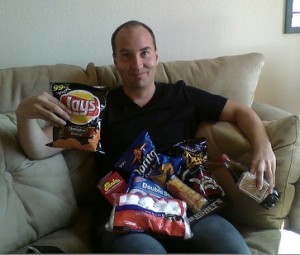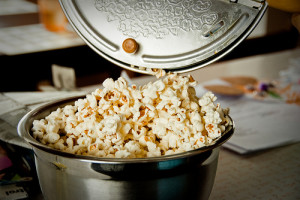by Michelle Sutton-Kerchner
When cravings hit, it may seem you’re living to eat rather than eating to live. Stop the madness. You don’t need to eat your way out of winter’s harsh clutch …
If we only craved food when our body needed fuel, when actually hungry, nutrition would be so much easier. Eating would be a routine habit, like brushing teeth, showering, and sleeping. We do those tasks for their long-term benefit. There is not any instant euphoria on our palate. We don’t consider a good dental flossing a reward for a hard day.

Our relationship with food is complicated. We need to eat, just as we need to accomplish many things for our health. Yet, eating provides more than just nutrition. We eat to satisfy emotional hunger, enjoy a social situation, and as a means to gather with friends and family.
Rewards come in the form of candy, cookies, or a cold beer at the end of a challenging day. Food answers the call of boredom. It is there when we’re jilted, nervous, and distraught with its instant sweet or salty relief. We befriend it when the world is failing us. It’s only a fridge away when a loved one may be out of reach. We exist; therefore, we snack.
Cravings
Mindless snacking is often born from cravings. Cravings are a natural part of being human. Food gives us pleasure; otherwise, our harried selves may skip more meals than we already do. Although tastes vary per person, certain cravings top everyone’s list.
Sugar and salt were once considered delicacies, sought after by many and enjoyed by an elite few. We evolved to crave these flavors, further proving humans always have wanted the unattainable. Today, these flavors are easily available in abundance. There exists the modern dangerous combination of having our cake and eating it, too. Food surrounds us, from the gas station, to the office, and on that quick errand to the department store. But, you do not have to eat it.
Are You Actually Hungry?

Determine the reason for a snack-attack (physical or emotional hunger). Then, make an informed decision on how to proceed. Here are key indicators of emotional eating:
- Hunger comes on suddenly and for a specific food.
- Your craving is strong and demands instant gratification.
- You continue to eat beyond feeling physically full.
- Your conscience whispers, “You’ll regret this later.”
Stress is not the only feeling that triggers emotional eating. People also indulge in comfort foods to maintain feelings of happiness, banish sad feelings, and overcome boredom. Interestingly, research has determined the snack choice (e.g., chips versus ice cream) varies according to mood.
Not Hungry After All?

Avoid emotional eating by satisfying your appetite with another activity that engages both the body and mind. Look around you and create some fun. Enjoy a quick chat with a friend. Do 20 jumping jacks. Walk around outside. Dash up and down the stairs. Replace the “need” to eat with another fulfilling activity.
Burn calories rather than consuming them. Hit the Center for a workout, swim, or soak in the spa pool. The latter may not burn calories but it is a sweet, fat-free indulgence. Enjoy a massage, stretching session, or brief meditation. Physical in nature, these engage both the body and mind. Train yourself to make these a new response when you normally (and needlessly) would reach for food. Distract yourself from the food craving with nonedible soothing, enjoyable treats.
If all else fails, have a glass of water. Sometimes, we mistake thirst with hunger. Maybe your body does need nourishment, but in the form of fluids. Mindfully drink a cup of tea or water with a slice of lemon. Avoid sugary soft drinks, a leading cause of today’s childhood obesity issue, which typically deliver 10 times the sugar amount needed in the bloodstream. According to the U.S. Department of Agriculture, soda consumption has increased by 500 percent in the past 50 years. Hydrate with healthful refreshment that won’t make you crash later.
If You Are Hungry …
Snack smartly. Sugar has been proven addictive. Insulin production causes sugar to be pulled from the bloodstream. The brain needed that sugar, so you’ll crave more. This unhealthy cycle can lead to type 2 diabetes. Sugar weaning takes patience, and healthy doses of fresh fruit. The natural sweetness of fruit, and even some vegetables, helps you feel less deprived when reducing sugar in your diet.
Salty snacks also top the list of cravings. So much of today’s food is saturated with sodium, we cannot truly taste it. Excess salt masks true flavor rather than enhancing it. Gradually reduce salt-shaker use and experience food more fully. Nutrition experts suggest substituting a squeeze of lemon or lime for a shake of salt. It adds flavor and a pinch of vitamin C. Retrain your taste buds and learn to love the real flavors of your food. Most find they prefer the taste.
Sugar and salt are a staple in many food products today. Often, they are added for reasons unrelated to taste, including as a preservative. We easily can become addicted to their taste without adding our own. Read nutrition labels to see the sodium and sugar additives you probably didn’t even realize existed. Know what you are feeding your body.
Crunchy cravings don’t have to result in a handful (bagful?) of chips, extra bold with processed cheese. Crunch on fresh fruit and veggie sticks. Dip them in peanut butter for a hunger-satisfying protein boost, fat-free dressing, or Neufchatel cheese (a lower-fat substitute for cream cheese). Visiting with friends? Serve with several dip choices, including dark chocolate. Hey, it’s healthier than a platter of cookies.

Nuts and seeds are a healthy alternative to crunch. Hot-air popped popcorn is also a good option, a whole grain that is high in fiber and antioxidants. The air-filled nature of puffy snacks allows you to feel just as full as if you ate the same amount of a heavier choice. And, you often can enjoy them for longer, crunching away during a show or while catching up with a friend. Try flavored rice cakes instead of cookies or cheese puffs instead of potato chips.
A simple trick to minimize a snack-attack: Spice up your snacks. Try adding a dash of hot sauce to your trail mix. Sprinkle hot pepper flakes in dips and spreads. People consume less when food is spicy hot. Hmmm … Maybe those Doritos Jacked™ aren’t so bad after all. (Not.)
Benefit from Natural Energy
When the urge to snack cannot be distracted away, by exercise or otherwise, snack smartly. Reach for an energy boost. Make it meaningful by eating to eliminate fatigue. Avoid processed foods. Prepare your own snack mixes, which gives you control of ingredients.
Combine salt- and sugar-free versions of your favorites with their salted and sugary counterparts. Nuts, pretzels, seeds, and cereals are ideal for this combination. Both versions are often sold side-by-side. Gradually, you’ll find you can further reduce the sugar and salted versions in your snack staples.
Include a form of protein. This helps you feel full quickly without over indulging. High-protein snacks include soy nuts, peanut butter crackers, and yogurt. High-fiber treats also satisfy. Try fiber bars, dried fruit, and whole wheat crackers. Carefully check labels on fiber and protein bars. Calorie and sugar counts vary as greatly as the amount of nutrients in each.
Fat-Burning Snacks
Yellow peppers are metabolism boosters and can provide more vitamin C than an orange. Eggs are a great protein source. They also contain the essential amino acids needed to build muscle tissue. Have a few hard boiled and ready to grab for a small but filling snack. Fruit smoothies made with whey protein are an ideal snack for dieters. The whey helps you feel full and reduces the loss of lean muscle mass common when dieting.
Although calorie-dense, peanuts have a thermic effect which means you significantly burn calories during the digestion process. According to a study in the International Journal of Obesity and Related Metabolic Disorders, those who consumed 500 calories in peanuts daily over a 19-week period increased their metabolic resting rate by 11 percent without any variation in exercise.
It’s Snack-Smart Season
 It is a great time of year to focus on eating better. The holidays are behind us. The comfort foods of winter are not as tempting. And, yes, swimsuit season is only a few calendar pages away. Celebrate the season with a healthier way of snacking. We learn more each day about the impact of little things on life. Create a healthier lifestyle, one nibble at a time.
It is a great time of year to focus on eating better. The holidays are behind us. The comfort foods of winter are not as tempting. And, yes, swimsuit season is only a few calendar pages away. Celebrate the season with a healthier way of snacking. We learn more each day about the impact of little things on life. Create a healthier lifestyle, one nibble at a time.
Sources
“Why We Desire Certain Foods,” by Chris Iliades at www.everydayhealth.com
“6 Fat-Fighting Superfoods,” by Amy Paturel at www.fitnessmagazine.com.
www.webmd.com
Image Credits
Fridge raid: www.flickr.com/photos/80546354@N00/8399277685/
Couch-potato junk: http://www.flickr.com/photos/74886061@N00/213665064/
Popcorn: www.flickr.com/photos/thomaslife/4564111313/
Fruit & veggie bouquet: www.flickr.com/photos/clayirving/2190801546/
 Fitness & Wellness News Your Source for Fitness News, Wellness News, Health News, and Nutrition News!
Fitness & Wellness News Your Source for Fitness News, Wellness News, Health News, and Nutrition News!




